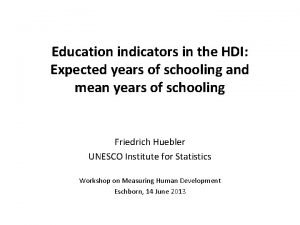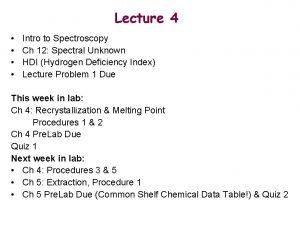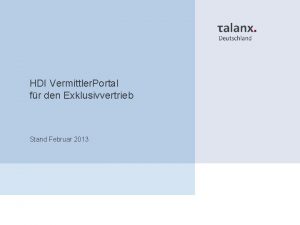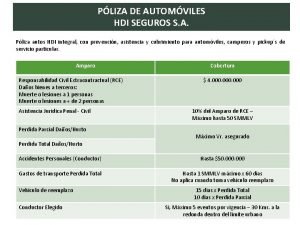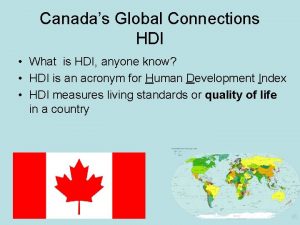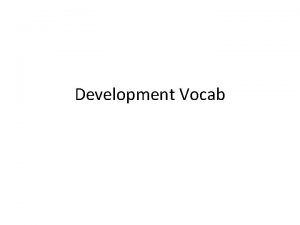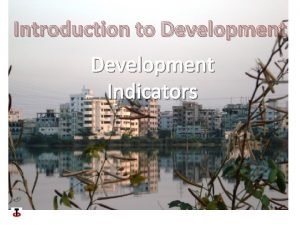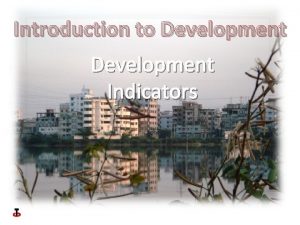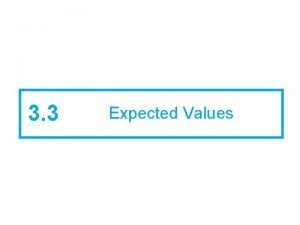Education indicators in the HDI Expected years of












- Slides: 12

Education indicators in the HDI: Expected years of schooling and mean years of schooling Friedrich Huebler UNESCO Institute for Statistics Workshop on Measuring Human Development Eschborn, 14 June 2013

Indicator 1: School life expectancy • SLE is the UIS term for expected years of schooling • Definition: SLE = number of years a child of school entrance age can expect to spend in a given level of education • Example: SLE for primary to secondary education – 4 grades of primary, 8 grades of secondary education – All children complete secondary education – All children repeat one grade – SLE for primary to secondary education = 13 years Slide 1 of 10

Calculation of SLE = sum of age specific enrolment rates for a given level of education School life expectancy at age a for level l in year t Enrolment of population at age i in level l in year t Population of age i in year t Enrolment of unknown age in level l in year t School-age population for level l in year t Theoretical duration of level l in year t Slide 2 of 10

SLE for primary to tertiary education, 2008 -2012 SLE ISCED 1 -6: Min. 4. 6 years Mean 13. 2 years Max. 19. 7 years Source: UIS database, June 2013. Latest available data for 139 countries. Slide 3 of 10

Interpretation of SLE: Factors to consider 1. Treatment of pre-primary education – UIS excludes enrolment in ISCED 0 2. Starting age for calculation of SLE – UIS considers enrolment of all ages (0 years and older) – Small effect: small enrolment divided by large population 3. Repetition – High number of repeaters means more years spent in school – Alternative: SLE net of repetition 4. Adult education – Included in calculation of SLE for some countries until 2003 5. Full-time equivalent – No distinction between part-time and full-time education 6. Enrolment and population from different sources of data 7. Changes in education systems over time Slide 4 of 10

Calculation of SLE net of repetition School life expectancy at age a for level l in year t Enrolment of population at age i in level l in year t Population of age i in year t Enrolment of unknown age in level l in year t School-age population for level l in year t Theoretical duration of level l in year t Repeaters in level l in year t Note: SLEN can only be calculated for ISCED levels 1 to 3. No data on repeaters for higher levels. Slide 5 of 10

SLE and SLE net of repetition, ISCED 1 -3, 2008 -2012 Difference SLE – SLEN: Min. 0 years Mean 0. 49 years Max. 4. 03 years Source: UIS database, June 2013. Latest available data for 124 countries. Slide 6 of 10

Indicator 2: Mean years of schooling • Definition: average number of completed years of education of a population (HDI: 25 years and older) • Indicator not yet produced by UIS • Goal: first UIS MYS database by October 2013, in collaboration with HDRO • UIS has data on educational attainment for years since 1946 • Annual UIS survey on educational attainment: Highest level of education completed for population 10 years and older Slide 7 of 10

Calculation of MYS • Similar approach as Barro and Lee (1993, 2010) Mean years of schooling Number of years of schooling for level l Share of population for which level l is highest level attained • Example: – 4 grades of primary, 8 grades of secondary education – 50% completed primary education – 50% completed secondary education – MYS = 0. 5× 4 + 0. 5×(4+8) = 2 + 6 = 8 years Slide 8 of 10

Challenges 1. Limited data coverage – Example: Sub-Saharan Africa: no data for 28 of 45 countries 2. Combination of levels of attainment – Example: Austria: 25% completed lower secondary (includes no schooling, incomplete primary, completed primary) 3. Limited data on incomplete levels of education – No data on percentage of population that started but did not complete ISCED levels 2 to 6 – No data on years completed of incomplete levels of education 4. Limited data on years spent in tertiary education 5. Changes in education systems over time 6. Foreign qualifications not always captured Slide 9 of 10

MYS: Next steps for UIS • Collection and analysis of educational attainment data – Review existing database – Collect and analyse data from additional sources, including household surveys – Revise UIS questionnaire on educational attainment to reflect changes in ISCED 2011, ask for data on MYS • Methodology – Test UIS model for MYS calculation, interpolation, projection – Document UIS methodology – Convene expert group to review and validate methodology • Dissemination – Disseminate first set of UIS MYS estimates by October 2013 – Expand UIS database – Establish country review of MYS data Slide 10 of 10

Contact information Friedrich Huebler Programme Specialist Education Indicators and Data Analysis UNESCO Institute for Statistics f. huebler@unesco. org www. uis. unesco. org
